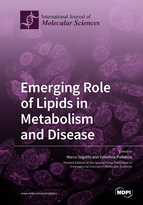Emerging Role of Lipids in Metabolism and Disease
A special issue of International Journal of Molecular Sciences (ISSN 1422-0067). This special issue belongs to the section "Molecular Endocrinology and Metabolism".
Deadline for manuscript submissions: closed (25 April 2020) | Viewed by 107932
Special Issue Editors
Interests: cholesterol metabolism; HMG-CoA reductase; neurodegeneration; neurodevelopmental diseases
Special Issues, Collections and Topics in MDPI journals
Interests: cholesterol; brain; neurotrophins; skeletal muscle; inflammation; signal transduction; autophagy; neurodegeneration
Special Issues, Collections and Topics in MDPI journals
Special Issue Information
Dear Colleagues,
Although initially regarded as a passive method of energy storage, lipids are now considered molecules with pivotal structural and functional roles. Notably, they serve as integral components of cellular membranes and act as crucial messengers in the regulation of cell homeostasis. In recent years, the role of lipids in homeostasis maintenance, derived from both nutrition and endogenous biosynthesis, attracted the interest of several researchers because of its involvement in human health. Lipid disorders are at the root of several diseases characterized by altered lipid metabolism in different tissues. Metabolic syndrome and cardiovascular disease, for instance, are closely related to these metabolic dysfunctions. Moreover, connections with misbalances of cholesterol homeostasis in neurodegenerative and neurodevelopmental disorders have also been demonstrated. Thus, the aim of this Special Issue is to gather research papers focused on this topic and, therefore, bring to the forefront new insights into physiopathological aspects of lipid disorders. Papers from different experts in the field will provide an interdisciplinary approach that will identify how the manipulation of lipid metabolism can represent a very attractive target for designing novel therapeutic targets to counteract several pathologies.
Prof. Dr. Valentina Pallottini
Dr. Marco Segatto
Guest Editors
Manuscript Submission Information
Manuscripts should be submitted online at www.mdpi.com by registering and logging in to this website. Once you are registered, click here to go to the submission form. Manuscripts can be submitted until the deadline. All submissions that pass pre-check are peer-reviewed. Accepted papers will be published continuously in the journal (as soon as accepted) and will be listed together on the special issue website. Research articles, review articles as well as short communications are invited. For planned papers, a title and short abstract (about 100 words) can be sent to the Editorial Office for announcement on this website.
Submitted manuscripts should not have been published previously, nor be under consideration for publication elsewhere (except conference proceedings papers). All manuscripts are thoroughly refereed through a single-blind peer-review process. A guide for authors and other relevant information for submission of manuscripts is available on the Instructions for Authors page. International Journal of Molecular Sciences is an international peer-reviewed open access semimonthly journal published by MDPI.
Please visit the Instructions for Authors page before submitting a manuscript. There is an Article Processing Charge (APC) for publication in this open access journal. For details about the APC please see here. Submitted papers should be well formatted and use good English. Authors may use MDPI's English editing service prior to publication or during author revisions.
Keywords
- Cholesterol
- Fatty acids
- Lipoproteins
- Lipids
- Metabolism
- Metabolic diseases
- Neurodegeneration and lipids
- Neurodevelopment and lipids
- Lipid signaling
- Lipids and inflammation
- Lipids in cancer
- Cardiovascular diseases
- Lipid rafts
- Post-translational lipid modifications
- Polyunsaturated fatty acids
- Cannabinoids
- Eicosanoids







